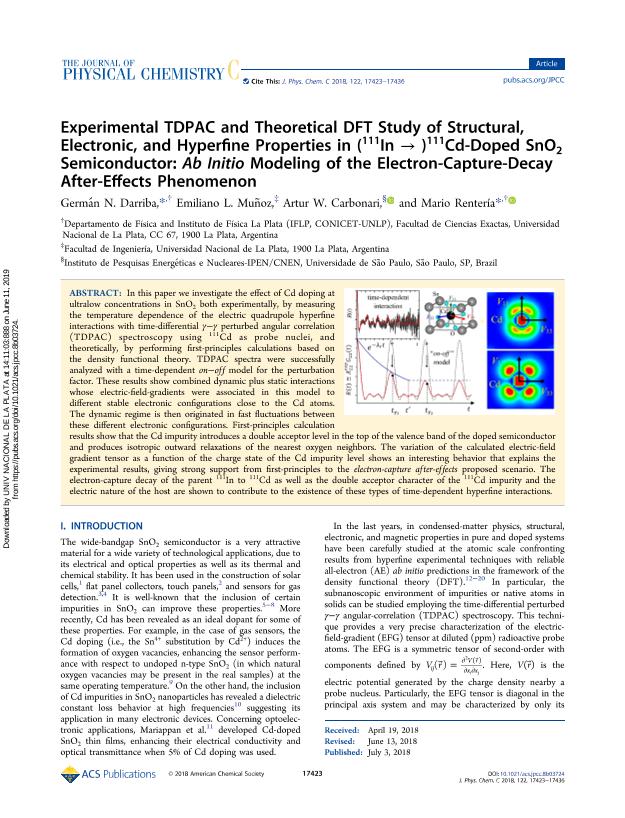Artículo
Experimental TDPAC and Theoretical DFT Study of Structural, Electronic, and Hyperfine Properties in (111In →)111Cd-Doped SnO2 Semiconductor: Ab Initio Modeling of the Electron-Capture-Decay After-Effects Phenomenon
Fecha de publicación:
08/2018
Editorial:
American Chemical Society
Revista:
Journal of Physical Chemistry C
ISSN:
1932-7447
Idioma:
Inglés
Tipo de recurso:
Artículo publicado
Clasificación temática:
Resumen
In this paper we investigate the effect of Cd doping at ultralow concentrations in SnO2 both experimentally, by measuring the temperature dependence of the electric quadrupole hyperfine interactions with time-differential γ−γ perturbed angular correlation (TDPAC) spectroscopy using 111Cd as probe nuclei, and theoretically, by performing first-principles calculations based on the density functional theory. TDPAC spectra were successfully analyzed with a time-dependent on−off model for the perturbation factor. These results show combined dynamic plus static interactions whose electric-field-gradients were associated in this model to different stable electronic configurations close to the Cd atoms. The dynamic regime is then originated in fast fluctuations between these different electronic configurations. First-principles calculation results show that the Cd impurity introduces a double acceptor level in the top of the valence band of the doped semiconductor and produces isotropic outward relaxations of the nearest oxygen neighbors. The variation of the calculated electric-field gradient tensor as a function of the charge state of the Cd impurity level shows an interesting behavior that explains the experimental results, giving strong support from first-principles to the electron-capture after-effects proposed scenario. The electron-capture decay of the parent 111In to 111Cd as well as the double acceptor character of the 111Cd impurity and the electric nature of the host are shown to contribute to the existence of these types of time-dependent hyperfine interactions.
Archivos asociados
Licencia
Identificadores
Colecciones
Articulos(IFLP)
Articulos de INST.DE FISICA LA PLATA
Articulos de INST.DE FISICA LA PLATA
Citación
Darriba, German Nicolas; Muñoz, Emiliano Luis; Carbonari, Artur Wilson; Rentería, Mario; Experimental TDPAC and Theoretical DFT Study of Structural, Electronic, and Hyperfine Properties in (111In →)111Cd-Doped SnO2 Semiconductor: Ab Initio Modeling of the Electron-Capture-Decay After-Effects Phenomenon; American Chemical Society; Journal of Physical Chemistry C; 122; 30; 8-2018; 17423-17436
Compartir
Altmétricas




